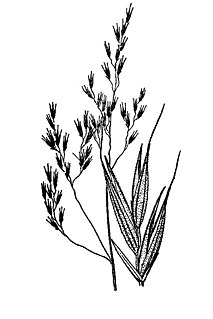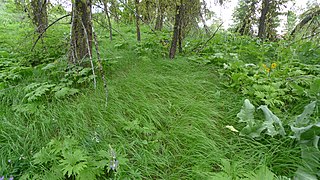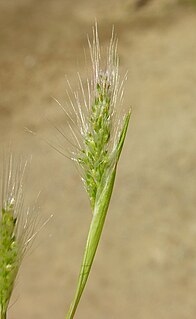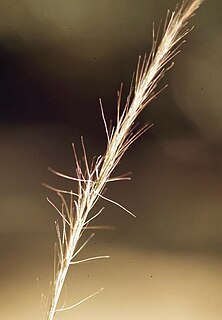
Festuca elmeri is a species of grass known by the common names coast fescue and Elmer's fescue. It is a bunchgrass native to the US states of California and Oregon, where it often grows in wet, shady areas in coastal counties.

Achnatherum lettermanii is a species of grass known by the common name Letterman's needlegrass. The updated and accepted name is Stipa lettermanii. It is native to the western United States from California to Montana to New Mexico, where it is a resident of several types of habitat.

Stipa parishii, formerly classified as Achnatherum parishii, is a species of grass known by the common name Parish's needlegrass. The Jepson Manual 2nd edition (2012) reclassified the plant as Stipa parishii var. parishii.

Stipa speciosa (syn. Achnatherum speciosum is a species of grass known by the common name desert needlegrass. It is native to much of the south-western United States from California to Colorado, where it grows in dry areas, especially sagebrush habitat. It is also known from Mexico and parts of South America.

Aristida californica is a species of grass known by the common names California threeawn and Mojave threeawn. It is native to the Mojave Deserts and Sonoran of northern Mexico and California and Arizona.

Aristida divaricata is a species of grass known by the common name poverty threeawn. It is native to the Americas from the central United States to Guatemala. It is a perennial grass forming clumps of unbranched stems up to 70 centimeters tall. Leaves are mostly basal and roll along the edges. The sparse inflorescence is a wide, flat, open array of spikelets that break apart easily. The grain has a twisted tip and three awns up to 2 centimeters long.

Bromus vulgaris is a species of brome grass known by the common name Columbia brome.

Calamagrostis rubescens is a species of grass known by the common name pinegrass.

Cynosurus echinatus is a species of grass known by the common names bristly dogstail grass, rough dog's-tail and hedgehog dogtail. It is native to southern Europe, and it is known in the Americas and Australia as an introduced species and sometimes a noxious weed. An herbicide-resistant strain can be found growing as a weed in canola and wheat fields in Chile. This is an annual grass growing 10 to 50 centimeters tall. The inflorescence is a rounded or oval cluster or series of clusters of spikelets. The fertile spikelet has an awn up to a centimeter long. The awns clumped closely together into a tuft gives the inflorescence its bristly, hairy appearance.

Polypogon monspeliensis, commonly known as annual beard-grass or annual rabbitsfoot grass, is a species of grass. It is native to southern Europe, but it can be found today throughout the world as an introduced species and sometimes a noxious weed. It is an annual grass growing to heights between 5 centimeters and one meter. The soft, fluffy inflorescence is a dense, greenish, plumelike panicle, sometimes divided into lobes. The spikelets have long, thin, whitish awns, which give the inflorescence its texture.

Muhlenbergia appressa, the Devils Canyon muhly, is a species of grass. It is native to the desert region where California and Arizona border Baja California. Muhlenbergia appressa has also been collected on San Clemente Island, one of the Channel Islands of California, in the chaparral and woodlands habitat..

Muhlenbergia microsperma is a species of grass known by the common name littleseed muhly. It is native to the Americas from the Southwestern United States and California through Central America into Peru and Venezuela.

Polypogon maritimus is a species of grass known by the common names Mediterranean beard grass and Mediterranean rabbitsfoot grass. It is native to the Mediterranean Basin. It is also known in other parts of the world, including Australia, New Zealand, and the United States, as an introduced species that can be found in moist habitat types. It is an annual grass producing stems up to half a meter tall. The inflorescence is a plumelike panicle up to 15 centimeters long containing many V-shaped spikelets with long awns.

Ventenata dubia is a species of grass known by the common names North Africa grass and wiregrass. It is native to southern Europe, North Africa and the Middle East. It is becoming well known in North America, where it is an introduced species and a noxious weed of cultivated and disturbed habitat. It is problematic in the Pacific Northwest, where it was first identified in Washington in 1952 and Idaho in 1957. It was found in Utah in 1996. It probably spreads when it gets mixed in with grass seed and is transported and inadvertently planted.

Achnatherum thurberianum is a species of grass known by the common name Thurber's needlegrass. It is native to the western United States, where it occurs from Washington to California and east to Montana and Wyoming.

Hesperostipa spartea, formerly Stipa spartea, is a species of grass known by the common names porcupine grass, western porcupine grass, short-awn porcupine grass, porcupine needlegrass, and big needlegrass. It is native to North America, where it is widespread from British Columbia to Ontario in Canada and through the central and Great Lakes regions of the United States. It is a bunchgrass species in the genus Hesperostipa.

Schizachyrium tenerum is a species of grass known by the common name slender little bluestem, or slender bluestem. It is native to the Americas, where it occurs in North, Central, and South America. In North America it can be found in the southeastern United States and much of Mexico.

Aristida purpurascens is a species of grass known by the common name arrowfeather threeawn. It is native to eastern North America. One of the three varieties has a distribution extending south into Honduras.

Bothriochloa pertusa is a species of grass. It is widely used as a fodder and a graze for livestock.

Dichanthium annulatum is a species of grass. It is commonly used as a forage for livestock.




















